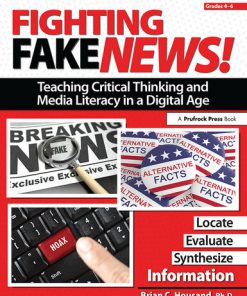How to Detect Media Bias and Propaganda in National and World News 4th Edition by Richard Paul, Linda Elder ISBN 9781538133897 153813389X
$50.00 Original price was: $50.00.$25.00Current price is: $25.00.
How to Detect Media Bias and Propaganda in National and World News 4th Edition by Richard Paul, Linda Elder – Ebook PDF Instant Download/Delivery: 9781538133897 ,153813389X
Full download How to Detect Media Bias and Propaganda in National and World News 4th Edition after payment

Product details:
ISBN 10: 153813389X
ISBN 13: 9781538133897
Author: Richard Paul, Linda Elder
Today’s instantaneous and ever-present news stream frequently presents a sensationalized or otherwise distorted view of the world, demanding constant critical engagement on the part of everyday citizens.
The Thinker’s Guide for Conscientious Citizens on How to Detect Media Bias and Propaganda in National and World News empowers readers to make sense of overwhelming and often subjective media by detecting ideology, slant, and spin at work. Richard Paul and Linda Elder focus on the internal logic of the news as well as societal influences on the media while illustrating essential elements of trustworthy journalism.
As part of the Thinker’s Guide Library, this book advances the mission of the Foundation for Critical Thinking to promote fair-minded critical societies through cultivating essential intellectual abilities and virtues across every field of study across world.
How to Detect Media Bias and Propaganda in National and World News 4th Edition Table of contents:
1. The Problem of Media Bias and Propaganda
-
The Role of the News Media in a Free Society
-
The Nature of Bias and Propaganda
-
Propaganda in Democratic vs. Authoritarian Societies
-
Why Critical Thinking Is Essential
2. Critical Thinking and the News Media
-
Elements of Reasoning and Intellectual Standards
-
How Critical Thinking Applies to News Consumption
-
Differentiating Fact, Inference, and Judgment
-
Recognizing Logical Fallacies in News
3. Understanding Media Ownership and Influence
-
Who Owns the News?
-
Corporate, Political, and Governmental Interests
-
Advertising and Its Influence on News Content
-
News as a Product: Ratings, Clicks, and Profits
4. Recognizing Biased Language and Framing
-
The Power of Words in Shaping Perception
-
Framing: What’s Emphasized vs. What’s Ignored
-
Loaded Language, Euphemisms, and Spin
-
Case Studies in Framing and Bias
5. Propaganda Techniques in the News
-
Fear Appeals and National Security Narratives
-
The “Us vs. Them” Mentality
-
The Illusion of Balance and False Equivalence
-
Emotional Manipulation and Hero/Villain Constructs
6. Analyzing the Structure of a News Report
-
Headline Analysis: Hook or Hype?
-
Sourcing: Who’s Speaking and Who’s Missing?
-
Placement and Visual Bias
-
What Questions Are Asked—and Not Asked?
7. Identifying Censorship by Omission or Emphasis
-
Underreporting and Overreporting
-
The Marginalization of Dissenting Voices
-
Soft Power and the Limits of Editorial Independence
-
Media Silence as a Tool of Control
8. Differentiating News from Opinion
-
Editorials, Op-eds, and Analysis Pieces
-
The Blurring of News and Commentary
-
Host Bias in Broadcast News
-
Social Media Influencers and the Illusion of Expertise
9. Techniques for Evaluating News Sources
-
Applying the Intellectual Standards of Critical Thinking
-
Evaluating Source Credibility and Integrity
-
Detecting Echo Chambers and Filter Bubbles
-
Developing a Reliable News Diet
10. Developing as a Critical News Consumer
-
Building Intellectual Courage and Humility
-
Becoming Actively Informed vs. Passively Indoctrinated
-
Engaging in Civil Dialogue About Media Narratives
-
Teaching Others to Detect Bias and Think Independently
People also search for How to Detect Media Bias and Propaganda in National and World News 4th Edition:
the thinker’s guide to moral decision making
the thinker’s guide to the art of socratic questioning
conscientious thinker
the thinking citizen
the thinker’s guide to fallacies pdf
You may also like…
Politics & Philosophy - Government & Politics
Education Studies & Teaching - Adult & Continuing Education
Relationships & Lifestyle - Personal Growth & Inspiration
Business & Economics - Economics











